Marko Geber
Berkshire Hills Bancorp, Inc. (NYSE: BHLB) had endured pandemic disruptions in the last two years. Its growth has been hampered as the interest rates approached near-zero levels. Even so, it is still operational, and its efforts seem to be paying off this year. Revenues and margins are rebounding with its prudent and efficient asset management. Its contraction helps it manage its expenses better to generate more income. Also, its interest-sensitive assets comprise more performing assets, improving its viability. Meanwhile, its financial leverage is well-managed, which shows its excellent liquidity position. Borrowings are relatively low even after the recent notes offerings. It matches with its recent share repurchases, keeping its financial leverage manageable. Dividends are well-covered as cash levels remain stable. Likewise, the stock price is lower but not cheap yet.
Company Performance
The past two years had not been exciting for Berkshire Hills Bancorp, Inc. In fact, it was one of the few companies in the financial sector that shrank amidst the near-zero interest rates. As part of the S&P 600, BHLB is already considered a large public bank. Its assets are interest-sensitive, so it may not be surprising that it had to contract to cope with the drastic changes in the market. All its loans decreased, given the lower interest rates. In turn, its interest fees on loans dropped as well.
But now, the company is making a strong rebound. Its reduction of non-performing assets and improvement of the quality of loans and deposits are paying off. Its prudent asset management, especially its enhanced loan originations are driving its growth. Also, its investment securities have been yielding higher returns in the last year. Its interest income as its primary revenue amounts to $87 million, a 2% increase from the comparative time series. Likewise, its dividend income from its investment securities is also in an uptrend. Again, the increase is not driven by the expansion of its operations, but by the enhanced quality of its earning assets. Its strategic loan and investment portfolio diversification are part of its core competencies.
Interest Income and Interest Expense (MarketWatch)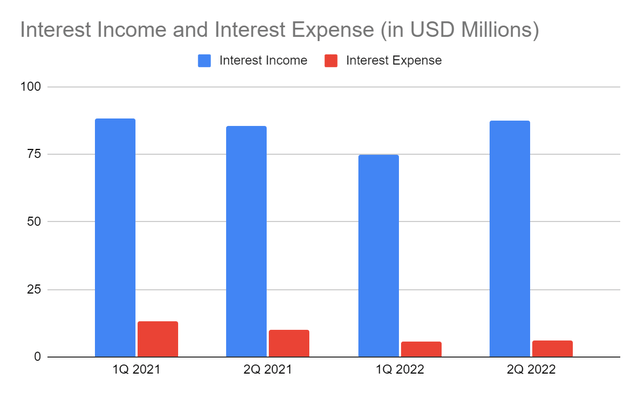
Moreover, efficient Balance Sheet management is also evident. It is leading to lower and more stable expenses. It is an impressive trend, given the rising interest rates. It is more evident in its enhanced loans and deposits. With its better loan origination, deposit management, and disposal of non-performing assets, revenues and expenses are moving in the opposite direction. With or without provisions, its net interest margin and operating margin are higher at 93% and 33%. As such, it derives more returns to sustain its strategic business mix changes and optimization initiatives. It remains in line with its plans to finance its BEST program and reduce non-strategic loans. It concentrates on its core business and maintains its impressive ESG ranking. With the continued increase in inflation, interest, and mortgage rates, BHLB must brace itself. Thankfully, it appears prepared for the macroeconomic pressures. I will discuss more of its core competencies in the next section.
Operating Margin (MarketWatch)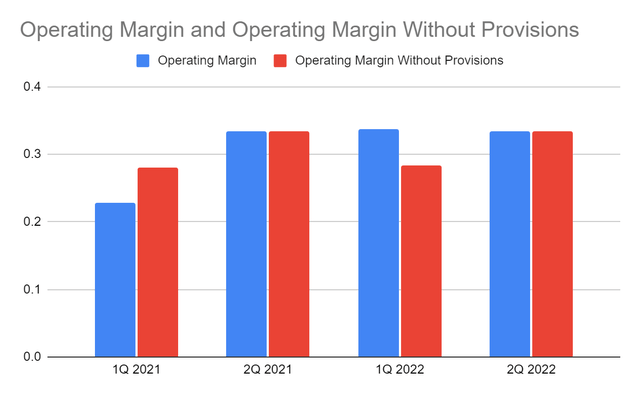
Macroeconomic Forces To Consider
Berkshire Hills Bancorp, Inc. is faced with multiple external pressures as borders reopen. The economic rebound in the last year has led to increased consumption and production. So now, we are seeing the impact of pent-up demand across industries. The continued increase in the general price level is evident now. In June, it had another all-time high inflation rate in four decades at 9.1%. Given the current trend, the estimation for this year may be higher. Likewise, the geopolitical unrest in Europe is another factor since Russia is an energy source. The supply chain disruptions amidst port congestion also affect prices. But, the pent-up demand appears to be the primary driver of the upsurge. These humongous changes are most evident in the real estate and automobile market. As such, I have to raise my inflation estimation. It is such a shame that I first thought it would transition and slow down during the second half. The current trend may indicate that it is yet to reach its peak. This year, I estimate it to climb up to 9.8%. But in the following years, the economy may become more stable, so it may drop to 5.2%.
To ensure this optimism, a series of interest and mortgage rate hikes must take place. In fact, the Fed has already raised the Federal Funds rate by 75 basis points last month. Also, the expected interest has been raised to 3.4% from the initial estimation of 3-3.25%. These projections are now far higher than the 1.7-2% projection earlier this year. Likewise, the mortgage rate has skyrocketed to 5.7%. It is already higher than the estimated mortgage rates at 5.1-5.3%. So, it may not be unsurprising if it reaches 7% this year. Nevertheless, I expect these macroeconomic indicators to become more manageable in 2024-2026. The fiscal and monetary policies may pay off although not as swiftly as initially expected.
Inflation Rate, Interest Rate, Mortgage Rate (Author Estimation, Barron’s, and Forbes)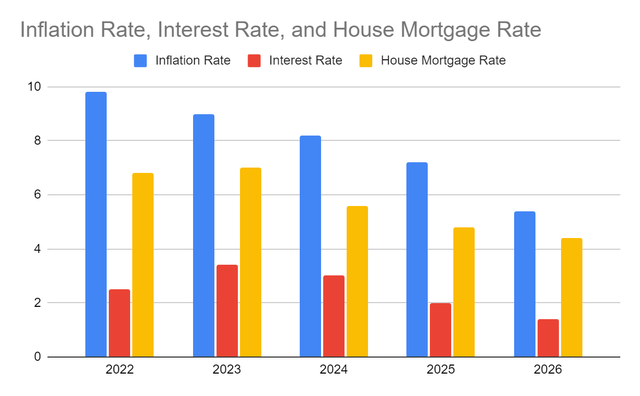
Why Berkshire Hills Bancorp, Inc,, May Stay Afloat
Berkshire Hills Bancorp, Inc. continues to make up for its slippages in the last two years. It maintains its large market visibility and improves its operational efficiencies. It can also cater to more customers, especially in New England, New York, and the Mid-Atlantic. It is also well-capitalized as part of the S&P 600. But what makes it well-positioned in the rising rate environment is its stellar Balance Sheet. Its asset-sensitive Balance Sheet is composed of more strategic earning assets. Its efforts to reduce its non-performing assets and diversify its loan and investment portfolio are now paying off. I already discussed its prudent loan and deposit and investment security management. But now, we have to check the strategic composition of its Balance Sheet that drives its viability and liquidity.
Loans, particularly mortgages and CI, remain its primary assets. That is why Berkshire must beware of the recent changes in interest and mortgage rates. Fortunately, asset quality metrics prove its efforts and prudence. For instance, the delinquency rate of its loans remains low at 0.55% vs 0.63% in 4Q 2021. It is also lower if we compare it to 2Q 2021. Likewise, non-accruing loans are lower by 9%. These percentages show that Berkshire becomes more efficient in handling loans. But of course, it remains conservative to keep its impressive liquidity position. Its provisions for credit losses are still realistic at 1.26%. On average, a bank of its size has provisions ranging from 0.9% to 1.2%. So, BHLB appears to be more cautious than many of its close peers.
Even better, its loan-to-deposit ratio remains low at 76%. The ideal ratio ranges at 80-90%. With that, it has more reserves to cover unexpected defaults and delinquencies. It also has more capacity to increase its loans to derive more interest income. Note that it appears more interest-sensitive, so it has better positioning in the rising interest mortgage rates. Deposits are also higher since higher interest rates entice more deposits. It can use these to invest or loan them out to derive more returns. It has a massive capacity to cushion the disruptive blows of inflationary pressures. Also, about 30% of its deposits are non-interest bearing. So, interest expenses may stay manageable amidst the increase in interest rates. The strategic way to manage its loans and deposits may help it sustain its viability and liquidity.
Loans, Deposits, and Loan-to-Deposit Ratio (MarketWatch)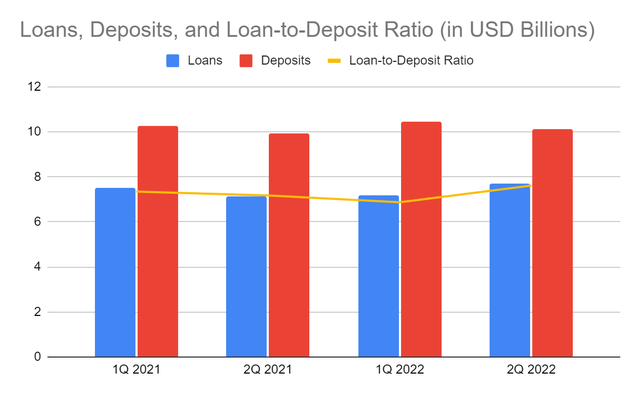
Likewise, its cash and investment securities comprise 28% of the total assets. They are more liquid assets, allowing them to suffice urgent business needs. Also, they are twelve times higher than borrowings. Cash alone can cover borrowings, including the recent notes offered. Berkshire is so liquid that it can make a single payment for its financial leverage using cash and investments alone. Also, it had a recent share repurchase, making its financial leverage well-managed even after issuing notes. That is why it is capable of expanding its operations and sustaining its optimization initiatives.
Only, investment securities appear to have slowed down in 2Q. It is logical since high interest rates reduce the appeal of bond and mortgage securities, which are typical for banks like Berkshire. For instance, yields were not as high as in 1Q. Breakeven yields for bond and mortgage securities reached 3% in April but decreased to 2.4% last month. Also, there may be more unrealized losses. The good thing is that BHLB keeps its provisions for security losses high, making its financial position more conservative. In the second half, securities may regain their appeal as recession concerns reemerge. Also, volatility does not appear to go into a lull this summer. These are still logical scenarios since the current inflation rate may drive the increase in interest rates. In turn, savings may rebound and drive the increase in investment security yields to offset long-run capital impacts. So, the increase in interest rates may still work for the company.
Cash and Investments and Borrowings (MarketWatch)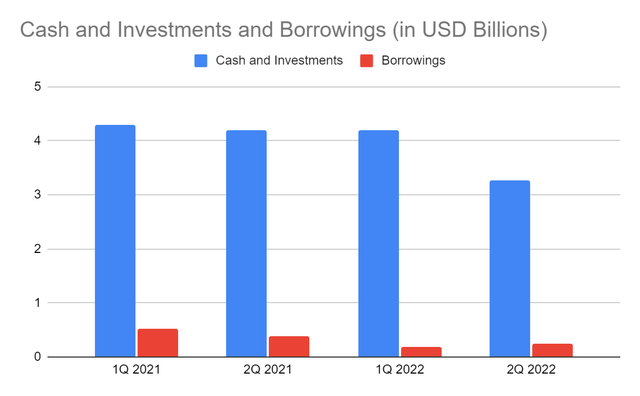
Another potential growth driver is its digital banking transformation. It is a must for me as more people go cashless. E-payments, digital wallets, and virtual and contactless cards are more of a staple today. Whether in emerging or mature economies, the decrease in cash transactions has sped up in the last two years. In the US, cash transactions dropped from 51% in 2010 to 22% in 2020. The same scenario is noticeable in Europe, especially in Scandinavia. That is why the digital transformation of the bank is long overdue and a must. It will allow the bank to enhance its efficiency and capture more customers.
Stock Price Assessment
The stock price of Berkshire Hills Bancorp, Inc. has been in a downtrend since the start of the year. Although there has been a rebound in the last month, the current price remains lower. At $26, it has already been cut by 8-10% from the starting price. It makes the stock price appear cheaper and more attractive. Its PE Ratio adheres to the cheapness of the stock price, which trades at a 10x earnings multiple. It is lower than the 15x valuation before the release of the 2Q report. But other valuations, such as the PB Ratio of 1.2 and the PTBV ratio of 1.24 shows that the stock price is not cheap. The Price-to-Operating Cash Flow of 13.80 also shows that the stock price is fairly valued.
Meanwhile, it still appears an attractive dividend stock even after the noticeable decrease in 2020. Thankfully, dividend payments are consistent but with an average dividend growth rate of 0.08%. Even so, dividend yield stays ideal at 1.79% vs the average of S&P 600 components at 1.41%. It is an aspect to consider before making a position. We can use the DCF Model and the Dividend Discount Model to assess the stock price better.
DCF Model
FCFF $24,000,000
Cash and Cash Equivalents $872,000,000
Borrowings $254,000,000
Perpetual Growth Rate 4.8%
WACC 9.8%
Common Shares Outstanding 45,788,000
Stock Price $26
Derived Value $24.42
Dividend Discount Model
Stock Price $26
Average Dividend Growth 0.00824
Estimated Dividends Per Share $0.48
Cost of Capital Equity 0.07475353643
Derived Value $24.67812987 or $24.68
Both models show the potential overvaluation of the stock price although it is still reasonable. There may be a potential downside of 8-12% in the next 12-24 months. Even so, it is still lower than pre-pandemic levels, making it relatively cheaper. The bullish trend in the last week is logical since it surpassed the recent earnings estimates. But, investors may have to wait for a better entry point.
Bottom Line
Berkshire Hills Bancorp, Inc. is making a noticeable comeback with its impressive margin expansion. It has a timely market and financial positioning, given its stellar Balance Sheet and optimization strategies. Also, dividends and financial leverage are well-covered with stable cash levels. But, the stock price does not appear to be cheap right now, so investors must wait for a better entry point. The recommendation, for now, is that Berkshire Hills Bancorp, Inc. is a hold.


Be the first to comment